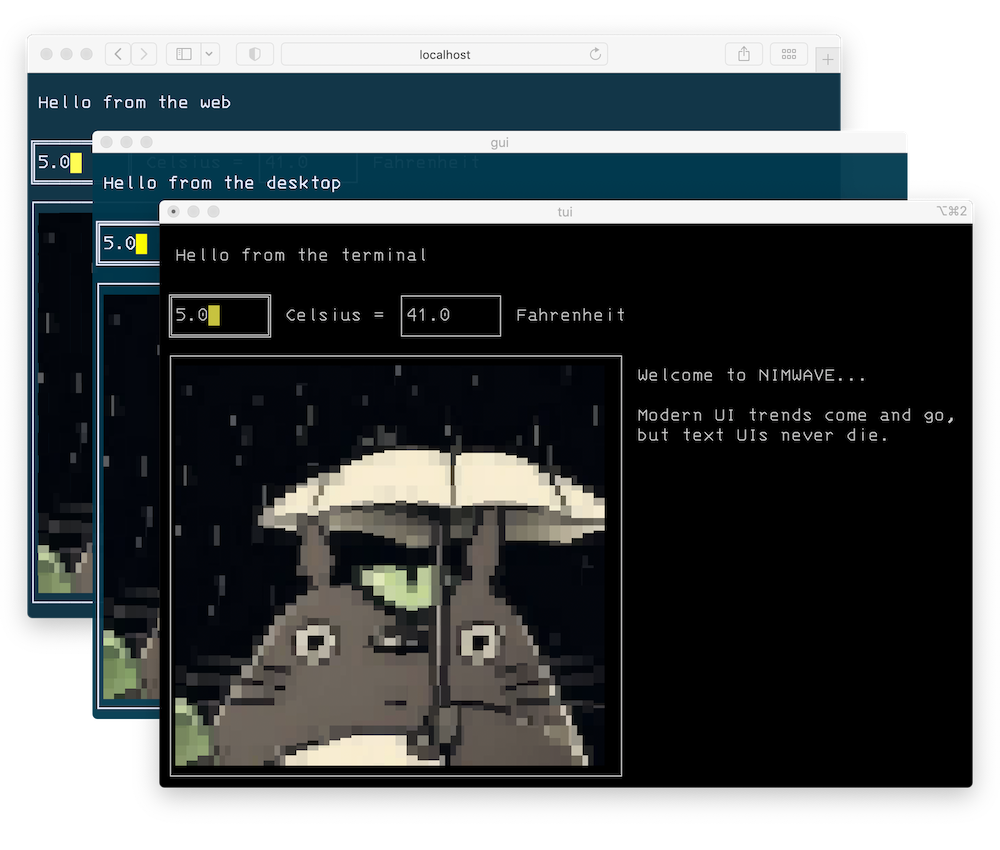With NIMWAVE, you can build TUI programs for the terminal, the desktop (via OpenGL/GLFW) and the web (via web assembly). Pedantic nerds love to point out that TUI stands for text user interface, not terminal. NIMWAVE is what happens when one of those nerds writes a library. Let's decouple TUIs from the terminal by running them where the normies are.
The best way to begin is to clone the starter project and run the commands in its README.
For a much more involved example project, see ANSIWAVE BBS. It is the project that NIMWAVE was extracted from.
NIMWAVE provides a way to build your UI with a hierarchy of nodes. Here's an example that renders a few lines of text:
render(
nw.Box(
direction: nw.Direction.Vertical,
border: nw.Border.Single,
children: nw.seq(
"Hello, world!",
"Nim rocks",
),
),
ctx
)The nw.Box is a built-in node. You can easily define your own nodes as well. For example, let's move that into a custom node:
type
MyCustomNode = ref object of nw.Node
lines: seq[string]
method render*(node: MyCustomNode, ctx: var nw.Context[State]) =
render(
nw.Box(
direction: nw.Direction.Vertical,
border: nw.Border.Single,
children: nw.seq(node.lines),
),
ctx
)Now it can be rendered like this:
render(MyCustomNode(lines: @["Hello, world!", "Nim rocks"]), ctx)By default, a node will receive a size from its parent node. This size can be found from iw.width(ctx.tb) and iw.height(ctx.tb). Any node can change its own size using nw.slice like this:
method render*(node: MyCustomNode, ctx: var nw.Context[State]) =
ctx = nw.slice(ctx, 0, 0, iw.width(ctx.tb), node.lines.len+2)
render(
nw.Box(
direction: nw.Direction.Vertical,
border: nw.Border.Single,
children: nw.seq(node.lines),
),
ctx
)Here, the node is retaining the width given to it by the parent, but it is resizing its height to be the number of lines of text plus 2 (for the border).
All low level render operations are dona via illwave. You can manipulate individual cells in the TerminalBuffer like this:
var cell = ctx.tb[0, 0]
# change the foreground/background color
cell.fg = iw.fgBlue
cell.bg = iw.bgYellow
# change the character
cell.ch = "Z".toRunes[0]
ctx.tb[0, 0] = cellThe coordinates here are relative, so 0, 0 will be the top left corner of the node you are in, not the top left corner of the entire terminal.
Also, strings may include ANSI escape codes directly:
render(nw.Text(str: "\e[32;43mHello, world!\e[0m"), ctx)Some nodes require local state. For example, let's make a button that increments a number every time it is clicked. First, we'll make a custom node for the button:
type
Button = ref object of nw.Node
str: string
mouse: iw.MouseInfo
action: proc ()
method render*(node: Button, ctx: var nw.Context[State]) =
ctx = nw.slice(ctx, 0, 0, node.str.runeLen+2, iw.height(ctx.tb))
if node.mouse.action == iw.MouseButtonAction.mbaPressed and iw.contains(ctx.tb, node.mouse):
node.action()
render(
nw.Box(
direction: nw.Direction.Horizontal,
border: nw.Border.Single,
children: nw.seq(node.str),
),
ctx
)Next, we make a node that places this button next to a count, and increments the count when the button is clicked:
type
Counter = ref object of nw.Node
mouse: iw.MouseInfo
count: int
method render*(node: Counter, ctx: var nw.Context[State]) =
let mnode = getMounted(node, ctx)
ctx = nw.slice(ctx, 0, 0, 15, 3)
proc incCount() =
mnode.count += 1
render(
nw.Box(
direction: nw.Direction.Horizontal,
border: nw.Border.None,
children: nw.seq(
nw.Box(
direction: nw.Direction.Horizontal,
border: nw.Border.Hidden,
children: nw.seq($mnode.count),
),
Button(str: "Count", mouse: node.mouse, action: incCount),
),
),
ctx
)For a node to maintain state, it must be "mounted", which just means its reference is stored in the context. When you call getMounted, it will look for the mounted version of that node and return it. If it hasn't been mounted yet, it'll do so. If you want to run custom code when a node mounts or unmounts, you can define a mount and unmount method with the same signature as render.
The mounted version, called mnode here, is the one you should use to read/write stateful data. Meanwhile, if you want to read any new data that came after mounting, such as the mouse data, you should read from the original node argument. If you tried reading that from mnode it would give you the value that it was when it mounted.
The Counter can then be rendered like this:
render(Counter(id: "counter", mouse: mouse), ctx)Note that all mounted nodes must have a unique id. If the parent node has an id, it is best to combine them together, such as node.id & "/counter", to ensure it will be unique. NIMWAVE tries its best to throw an error if you reuse an id, but it's not always possible to tell, so it is up to you to ensure this.
Another place to store state is inside the Context object. This object is passed to every node, so this is a nice way to pass state that should be accessible everywhere. The starter project defines it like this:
type
State = object
focusIndex*: int
focusAreas*: ref seq[iw.TerminalBuffer]
var ctx = nw.initContext[State]()This object is completely up to you to define, and it will be accessible to you from ctx.data. In this case, it contains state for a simple focus system. The starter project defines this function:
proc addFocusArea(ctx: var nw.Context[State]): bool =
result = ctx.data.focusIndex == ctx.data.focusAreas[].len
ctx.data.focusAreas[].add(ctx.tb)Inside nodes that should be focusable, you'll find let focused = addFocusArea(ctx) which adds the node's TerminalBuffer to the focusAreas and returns true if its length equals the focusIndex.
This is just one way to implement a focus system. Notice that this object is using both a value type and a ref type. Always consider what kind of behavior you want; value types will be copied from node to node, so if they are modified from inside a node, the change will only be visible to its own children. Use a ref type if you want all nodes to see/modify the same data.
